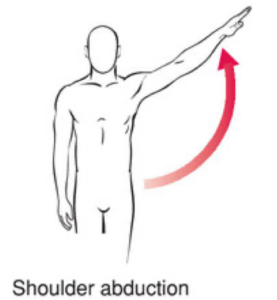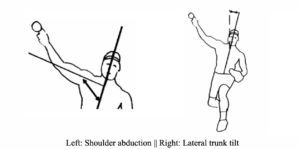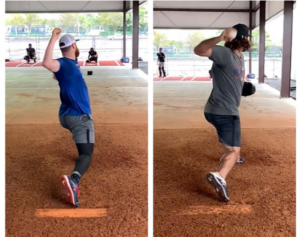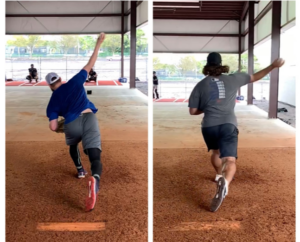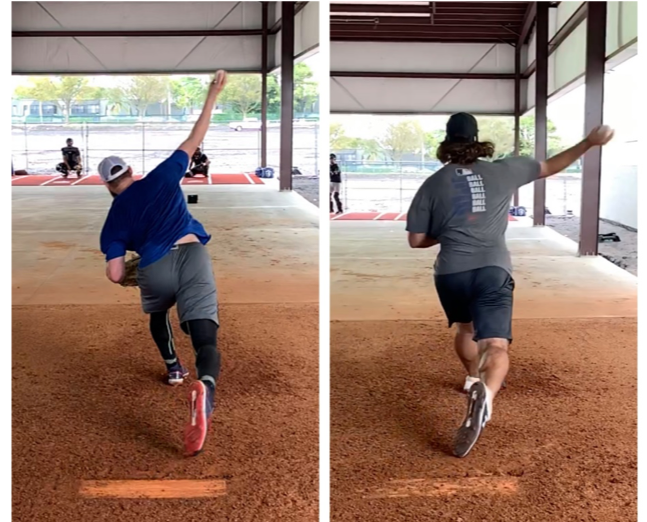
Pitching Mechanics: What’s in a Release Point?
Today’s guest post comes from Cressey Sports Performance – Florida Associate Pitching Coordinator, Mark Lowy. This post comes on the heels of Mark’s appearance on Episode 51 of the CSP Elite Baseball Development Podcast. During it, he discusses some of the intricacies of release point data and how he uses the numbers to help understand a pitchers delivery. This discussion in the podcast kicks off at the 20:30 mark. -EC
Back in the fall, Eric put together a great Instagram post on the similarities in upper body positioning between Oliver Drake and Adam Cimber, despite their incredibly different release points.
What we know from looking at video is that most pitchers release the ball in the neighborhood of 90 and 110 degrees of shoulder abduction. This is backed up by various studies over the years, and corroborated by current motion capture setups such as Simi and Kinatrax.
Therefore, we know that when looking at deliveries, we can hold shoulder abduction relatively constant across players, and understand that the lateral trunk tilt (right) a pitcher displays during the delivery is going to be a key contributor as to where they release the ball.
Source: https://journals.humankinetics.com/view/journals/jab/34/5/article-p377.xml
By understanding this, we can appreciate that the arm slot and ball release for any given pitcher is a result, and not a process in and of itself. If we can agree on this, it begs the question: what helps determine where in space a pitcher releases the ball?
To help answer this, we need to work backward. If you have ball release data available, a good place to start is with the vertical release point, the horizontal release point, and (if possible) the extension (how far down the mound the ball was released) of a given pitch. These three data points tell you where the pitch is coming in from. Rapsodo will give you the first two, while Trackman will give you all three.
If you do not have access to ball release data, don’t worry! It’s still important to coach with your eyes and understand the root cause when you notice something amiss with someone’s arm slot.
To break down the delivery effectively, we need to start from the ground up to understand what affects ball release. It’s important to recognize that each section could serve as its own article, but for time’s sake, we will hit on the big rocks in each group. From start to finish, we can identify:
A. Back leg direction and upper half positioning
B. Stride length to lead leg landing position
C. Trunk tilt into and through ball release
A. Back leg direction
This is an area that is frequently talked about in the pitching world, and with good reason. Since we understand that pitching is a series of highly-coordinated movements, we have to be able to consistently own the first one, as it sets up all events later in the chain.
A main goal of the back leg is to provide a) stability as the body begins to create and store energy and b) provide direction as the body begins to move down the slope. Some factors to take into account when breaking down the back leg of a pitcher can include:
- Ankle mobility into dorsiflexion and eversion
- Hip mobility in ER, IR, and flexion
- Anatomical structure of the hip (retroversion vs. anteversion)
- Postural tendencies of the upper half
For the sake of this article, we are going to look at the first and last bullets, as they are easier to identify on video. It’s worth mentioning that when breaking down a delivery, we always prefer video over still shots. However, pictures can be useful for comparison’s sake.
If you have an athlete with above average dorsiflexion (knee over toe range of motion), he may be able to get away with more forward knee translation while still maintaining contact with the ground during his load phase. Conversely, an athlete with stiff ankles may struggle to keep the foot anchored in the ground when the knee drifts forward, and will need to maintain a more vertical shin during their load. This can be determined in simple ankle mobility screen, and should also be looked at dynamically during a movement screen to see how well the athlete controls (or doesn’t control) the range of motion he has available to him.
As the back leg starts to bend, the lower half and upper half start to work together. On the right, a more flexed ankle/knee help bring the torso forward. On the left, a more stacked knee and ankle helps keep the trunk more upright.
This is where the postural tendencies of an athlete come into play. Athletes who are more extended and flat through the lumbar and thoracic spine generally take a more upright torso position as they begin to work down the slope, while athletes who are more neutral/rounded through the upper back may prefer to hold more torso lean forward.
B. Stride length to lead leg landing position
As the pitcher begins to move down the mound, there are a lot of factors to look at regarding his stride length and direction. From an assessment standpoint, we hone in on a few things:
- Adductor length (hip abduction range of motion)
- Hip internal rotation
- Thoracic spine mobility (active and passive)
These are three pieces among many that are going to influence a pitcher’s movement down the mound. It’s important to note that we do not coach guys to “push” or “drive” off the rubber – this commonly leads to early and aggressive hip extension, which throws off the timing and sequencing of the delivery. Instead, we want the front leg to land in a position that is a) comfortable for the pitcher and b) allows him to decelerate properly. This will look very different based on the points above.
Athletes with limitations in hip abduction are generally going to benefit from a shorter stride, as the longer the lead leg continues to search for distance, the tougher it is for the back leg to maintain tension into the ground. The flip side are hypermobile/loose pitchers who can get into whatever positions they want, and when trained to be able to create stability in these positions, they can be very effective.
Hip internal rotation can be looked at through a similar lens. Athletes with higher degrees of IR (anteverted hips, hypermobile, etc.) can get away with (and often find success with) a more closed off stride, as it allows them to create more tension and stability into the ground upon landing. They have the requisite room in the hip joint to be able to decelerate their upper and lower half in a closed off position. For athletes with hip IR limitations, a more closed off stride can be problematic down the road, as it forces them to adopt a deceleration pattern that does not dissipate stress as effectively as the hip and torso do when working together.
Stride length and path considerations should be taken into account for the upper half as well. For athletes who are less mobile through their thoracic spine, the longer the lead leg is floating in space, the more demand there is for them to resist torso rotation. The same can be true for someone with high degrees of passive thoracic range of motion, but low degrees of active. Those athletes crave stability, so the longer the lead leg is in the air, the less stability they have.
On the right, note the slightly closed off lead leg, versus the more open lead leg on the left. This is a function of the initial move with the back leg, and the following path of the front leg (and also gloveside). In these examples, we can see that when the torso follows the path of the lead leg, it helps the pitcher hold his line to the plate. If we swapped the lower halves in the two pictures, it would be very difficult for consistently create velocity while finding the strike zone.
C. Trunk tilt into and through ball release
As we are beginning to understand, every step in the delivery influences and sets up the next one. In the comparisons from above, we see how back leg direction can shape both front leg path and upper half direction as the pitcher moves down the slope.
As we get to ball release, the final picture now makes sense. On the left, the more upright torso, stacked lower leg position, and more open stride help pull the trunk up, raising the arm with it. On the right, initial back leg direction shapes a more closed landing position and more level shoulders through ball release.
It’s important to reiterate that this article is not an attempt to determine “right vs. wrong,” but look at different deliveries that exist on the spectrum of high performance. As coaches, the overall takeaway should be to find and create a delivery that recognizes individuality while also understanding how a pitcher’s anatomy plays a large role in how he looks on the mound.
About the Author
Mark Lowy serves as a Strength and Conditioning Coach and Associate Pitching Coordinator at CSP-FL. He completed his internship in the spring of 2018. Prior to joining the staff, Mark trained and coached high school and college athletes in the New York and New Jersey area. He also served as an assistant baseball coach at Ridgewood High School (NJ). Mark graduated from Gettysburg College in 2014. You can follow him on Twitter at @Mark_Lowy and on Instagram at @CSPFL_Pitching.


